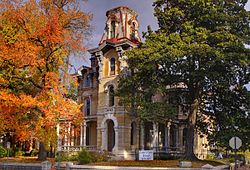Victorian Village, Memphis
|
Victorian Village District
|
|

Harsson-Goyer-Lee House, 690 East Adams Street
|
|
| Location | Adams and Jefferson Sts., Memphis, Tennessee |
|---|---|
| Coordinates | 35°8′42″N 90°2′20″W / 35.14500°N 90.03889°WCoordinates: 35°8′42″N 90°2′20″W / 35.14500°N 90.03889°W |
| Area | 28 acres (11 ha) |
| Architect | Multiple |
| Architectural style | Greek Revival, Late Victorian, Italianate |
| NRHP Reference # | 72001253 |
| Added to NRHP | December 11, 1972 |
The Victorian Village District is an area of Memphis, Tennessee.
The Victorian Village is located in the eastern quadrant of downtown Memphis.
During Memphis' early period of growth in the mid-19th century, a few wealthy Memphians built grand, Victorian-style homes in what was then the outskirts of the city. The homes in Victorian Village were built from 1846 into the 1890s, and range in style from Neo-classical through Late Gothic Revival.Edward C. Jones, one of Memphis's most significant Victorian-era architects, and his partner, Matthias Harvey Baldwin, built the Woodruff-Fontaine House (1870) and renovated the Harsson-Goyer-Lee House (1871).
Mallory-Neely House]]
The Massey House, the oldest in the area (ca. 1846), was built for Benjamin A. Massey, an early Memphis lawyer.
The Mallory-Neely House (1852) was built in Italian villa style with a central tower for banker Isaac Kirtland and extensively renovated and expanded during the 1880s and 1890s. The interior is well preserved, with much of the original late-19th-century furnishings intact.
The Harsson-Goyer-Lee House (690 Adams, see photograph) was once the home of riverboat owner James Lee. It was expanded in 1871 by Charles Goyer, a founder of Union Planters Bank.
The Pillow-McIntyre House (ca. 1852) is a two-story Greek Revival home purchased in 1873 by Mexican War and Confederate General Gideon Pillow. This striking eclectic-style Victorian had been unused for years, but with the assistance of corporate and community donations it was refurbished in 2004.
The Woodruff-Fontaine House (1870) was built in French-Victorian style by Amos Woodruff, a successful carriage maker, entrepreneur and politician. The second resident, Noland Fontaine, was a factor in the Memphis Cotton Exchange. The house was deeded to the city in 1936, and in later years was used for an art school. In 1961 the art school moved, and the Association for the Preservation of Tennessee Antiquities took over the house and restored it with 19th-century regional antiques and textiles. A Victorian Gingerbread playhouse is also on the grounds.
...
Wikipedia


